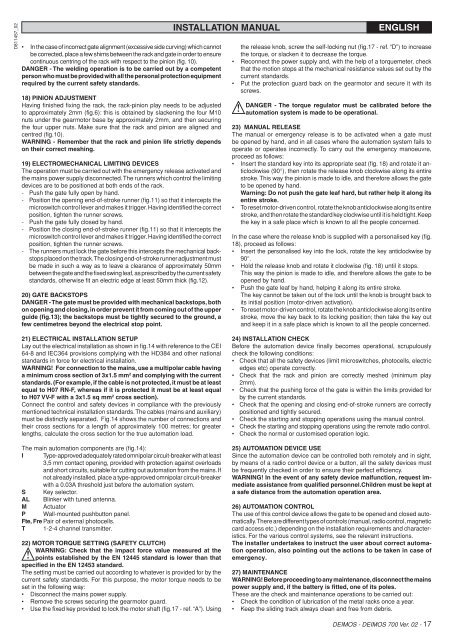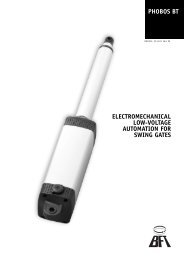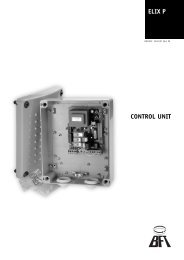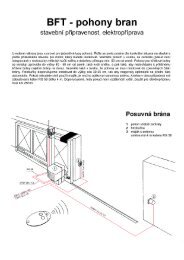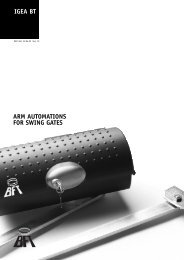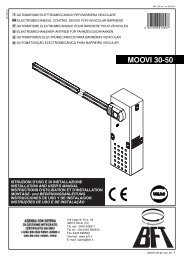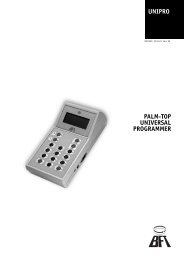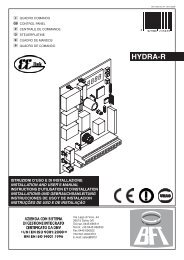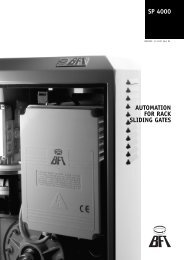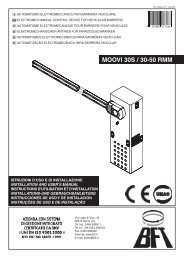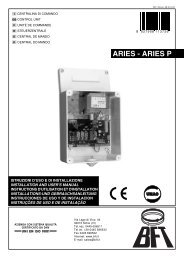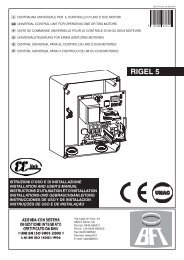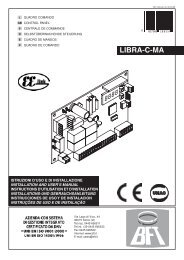DEIMOS-DEIMOS 700
DEIMOS-DEIMOS 700
DEIMOS-DEIMOS 700
You also want an ePaper? Increase the reach of your titles
YUMPU automatically turns print PDFs into web optimized ePapers that Google loves.
D811457_02• In the case of incorrect gate alignment (excessive side curving) which cannotbe corrected, place a few shims between the rack and gate in order to ensurecontinuous centring of the rack with respect to the pinion (fig. 10).DANGER - The welding operation is to be carried out by a competentperson who must be provided with all the personal protection equipmentrequired by the current safety standards.18) PINION ADJUSTMENTHaving finished fixing the rack, the rack-pinion play needs to be adjustedto approximately 2mm (fig.6): this is obtained by slackening the four M10nuts under the gearmotor base by approximately 2mm, and then securingthe four upper nuts. Make sure that the rack and pinion are aligned andcentred (fig.10).WARNING - Remember that the rack and pinion life strictly dependson their correct meshing.19) ELECTROMECHANICAL LIMITING DEVICESThe operation must be carried out with the emergency release activated andthe mains power supply disconnected. The runners which control the limitingdevices are to be positioned at both ends of the rack.- Push the gate fully open by hand.- Position the opening end-of-stroke runner (fig.11) so that it intercepts themicroswitch control lever and makes it trigger. Having identified the correctposition, tighten the runner screws.- Push the gate fully closed by hand.- Position the closing end-of-stroke runner (fig.11) so that it intercepts themicroswitch control lever and makes it trigger. Having identified the correctposition, tighten the runner screws.- The runners must lock the gate before this intercepts the mechanical backstopsplaced on the track. The closing end-of-stroke runner adjustment mustbe made in such a way as to leave a clearance of approximately 50mmbetween the gate and the fixed swing leaf, as prescribed by the current safetystandards, otherwise fit an electric edge at least 50mm thick (fig.12).20) GATE BACKSTOPSDANGER - The gate must be provided with mechanical backstops, bothon opening and closing, in order prevent it from coming out of the upperguide (fig.13); the backstops must be tightly secured to the ground, afew centimetres beyond the electrical stop point.INSTALLATION MANUALENGLISHthe release knob, screw the self-locking nut (fig.17 - ref. “D”) to increasethe torque, or slacken it to decrease the torque.• Reconnect the power supply and, with the help of a torquemeter, checkthat the motion stops at the mechanical resistance values set out by thecurrent standards.• Put the protection guard back on the gearmotor and secure it with itsscrews.DANGER - The torque regulator must be calibrated before theautomation system is made to be operational.23) MANUAL RELEASEThe manual or emergency release is to be activated when a gate mustbe opened by hand, and in all cases where the automation system fails tooperate or operates incorrectly. To carry out the emergency manoeuvre,proceed as follows:• Insert the standard key into its appropriate seat (fig. 18) and rotate it anticlockwise(90°), then rotate the release knob clockwise along its entirestroke. This way the pinion is made to idle, and therefore allows the gateto be opened by hand.Warning: Do not push the gate leaf hard, but rather help it along itsentire stroke.• To reset motor-driven control, rotate the knob anticlockwise along its entirestroke, and then rotate the standard key clockwise until it is held tight. Keepthe key in a safe place which is known to all the people concerned.In the case where the release knob is supplied with a personalised key (fig.18), proceed as follows:• Insert the personalised key into the lock, rotate the key anticlockwise by90°.• Hold the release knob and rotate it clockwise (fig. 18) until it stops.This way the pinion is made to idle, and therefore allows the gate to beopened by hand.• Push the gate leaf by hand, helping it along its entire stroke.The key cannot be taken out of the lock until the knob is brought back toits initial position (motor-driven activation).• To reset motor-driven control, rotate the knob anticlockwise along its entirestroke, move the key back to its locking position; then take the key outand keep it in a safe place which is known to all the people concerned.21) ELECTRICAL INSTALLATION SETUPLay out the electrical installation as shown in fig.14 with reference to the CEI64-8 and IEC364 provisions complying with the HD384 and other nationalstandards in force for electrical installation.WARNING! For connection to the mains, use a multipolar cable havinga minimum cross section of 3x1.5 mm 2 and complying with the currentstandards. (For example, if the cable is not protected, it must be at leastequal to H07 RN-F, whereas if it is protected it must be at least equalto H07 VV-F with a 3x1.5 sq mm 2 cross section).Connect the control and safety devices in compliance with the previouslymentioned technical installation standards. The cables (mains and auxiliary)must be distinctly separated. Fig.14 shows the number of connections andtheir cross sections for a length of approximately 100 metres; for greaterlengths, calculate the cross section for the true automation load.The main automation components are (fig.14):I Type-approved adequately rated omnipolar circuit-breaker with at least3,5 mm contact opening, provided with protection against overloadsand short circuits, suitable for cutting out automation from the mains. Ifnot already installed, place a type-approved omnipolar circuit-breakerwith a 0.03A threshold just before the automation system.S Key selector.AL Blinker with tuned antenna.M ActuatorP Wall-mounted pushbutton panel.Fte, Fre Pair of external photocells.T 1-2-4 channel transmitter.22) MOTOR TORQUE SETTING (SAFETY CLUTCH)WARNING: Check that the impact force value measured at thepoints established by the EN 12445 standard is lower than thatspecified in the EN 12453 standard.The setting must be carried out according to whatever is provided for by thecurrent safety standards. For this purpose, the motor torque needs to beset in the following way:• Disconnect the mains power supply.• Remove the screws securing the gearmotor guard.• Use the fixed key provided to lock the motor shaft (fig.17 - ref. “A”). Using24) INSTALLATION CHECKBefore the automation device finally becomes operational, scrupulouslycheck the following conditions:• Check that all the safety devices (limit microswitches, photocells, electricedges etc) operate correctly.• Check that the rack and pinion are correctly meshed (minimum play2mm).• Check that the pushing force of the gate is within the limits provided forby the current standards.• Check that the opening and closing end-of-stroke runners are correctlypositioned and tightly secured.• Check the starting and stopping operations using the manual control.• Check the starting and stopping operations using the remote radio control.• Check the normal or customised operation logic.25) AUTOMATION DEVICE USESince the automation device can be controlled both remotely and in sight,by means of a radio control device or a button, all the safety devices mustbe frequently checked in order to ensure their perfect efficiency.WARNING! In the event of any safety device malfunction, request immediateassistance from qualified personnel.Children must be kept ata safe distance from the automation operation area.26) AUTOMATION CONTROLThe use of this control device allows the gate to be opened and closed automatically.There are different types of controls (manual, radio control, magneticcard access etc.) depending on the installation requirements and characteristics.For the various control systems, see the relevant instructions.The installer undertakes to instruct the user about correct automationoperation, also pointing out the actions to be taken in case ofemergency.27) MAINTENANCEWARNING! Before proceeding to any maintenance, disconnect the mainspower supply and, if the battery is fitted, one of its poles.These are the check and maintenance operations to be carried out:• Check the condition of lubrication of the metal racks once a year.• Keep the sliding track always clean and free from debris.<strong>DEIMOS</strong> - <strong>DEIMOS</strong> <strong>700</strong> Ver. 02 - 17


